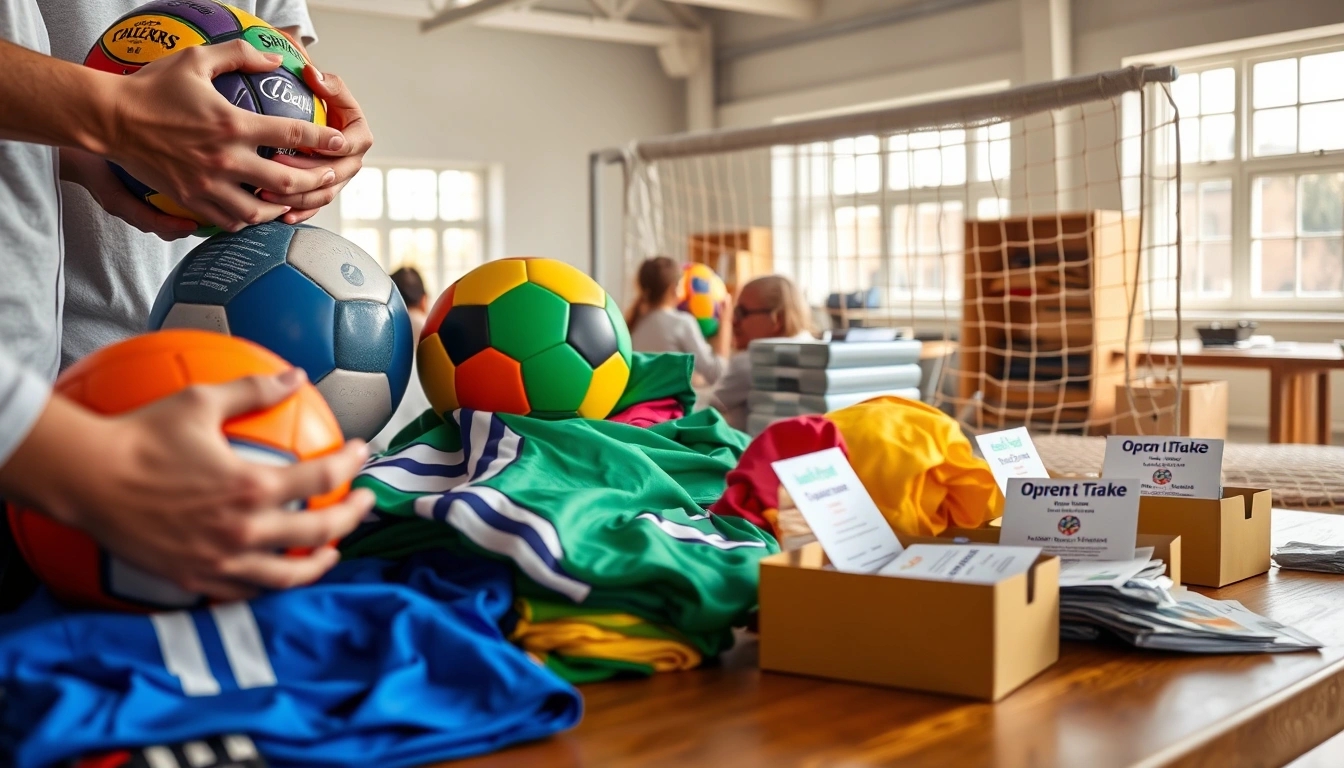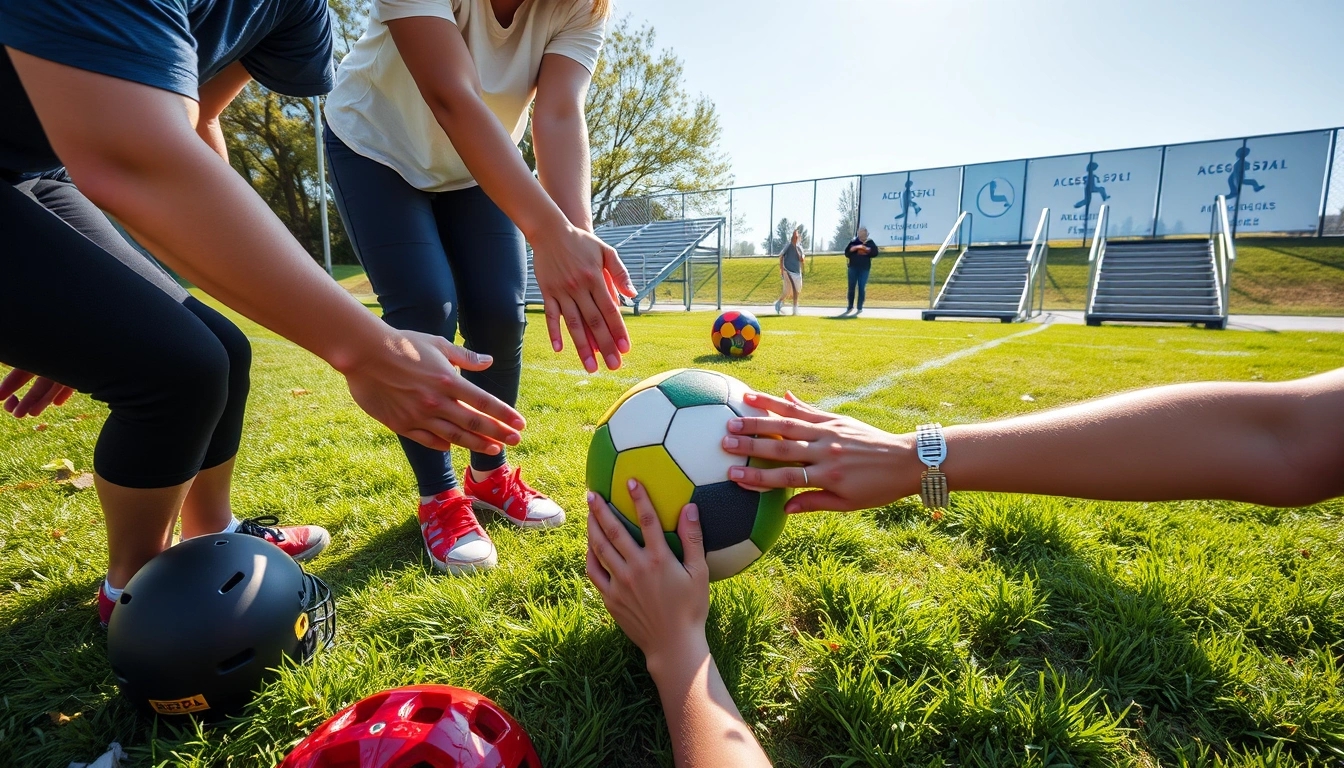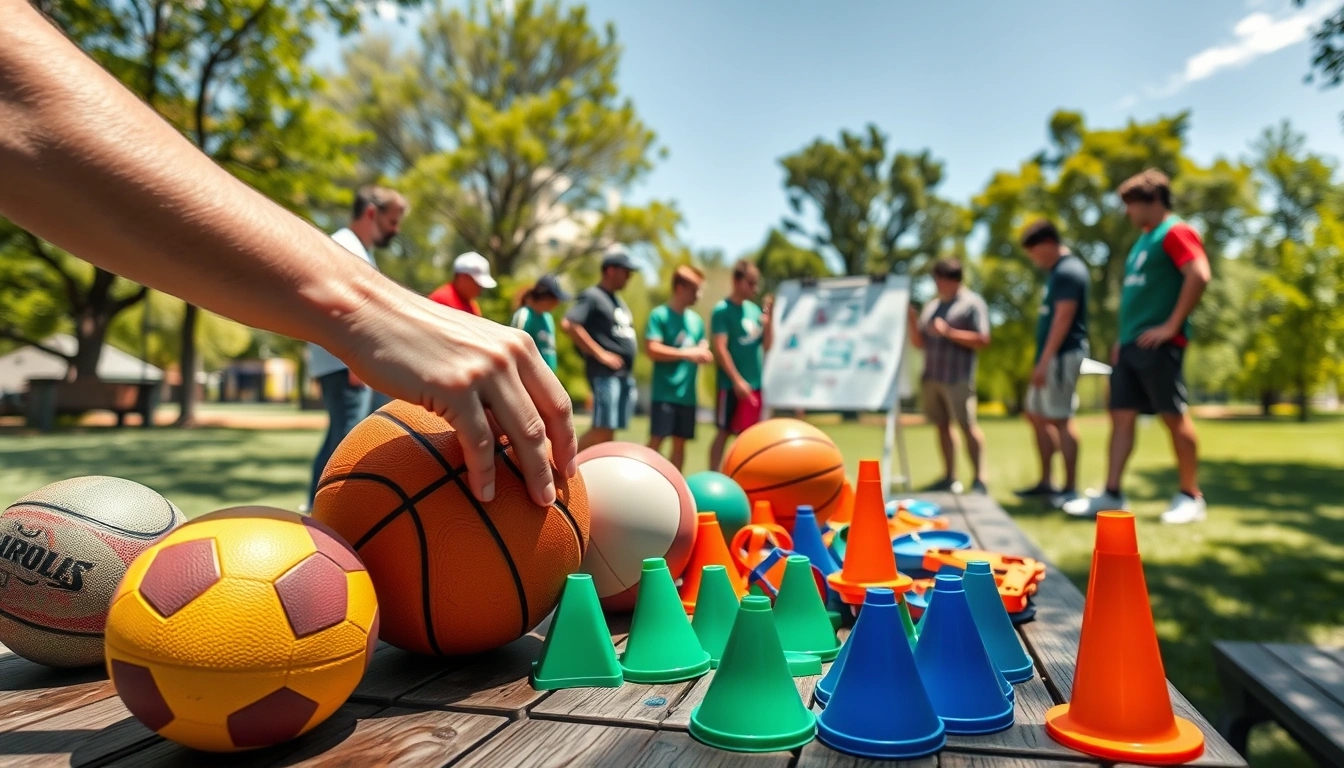Starting a community sports group? Buckle up, because it’s a bit like herding cats—but the cats are sweaty, competitive, and really want to play. You might think it’s just about grabbing a ball and yelling “game on!” but nope, there’s a whole lot more behind the scenes. Don’t worry though, with some savvy moves and a sprinkle of patience, you’ll have a squad ready to rumble in no time.
Finding Your Sport and Audience
First things first: what sport are you even talking about? Not everyone’s itching for dodgeball or ultimate frisbee, but you’d be surprised who’s lurking in the shadows ready to jump in. Think about your community—kids, adults, seniors? Casual players or die-hard competitors? Nail down who you want to attract because that shapes everything else.
- Survey your neighborhood or social media circles for interest.
- Check out local schools or community centers for popular sports.
- Don’t be afraid to mix it up—sometimes the weirdest sports draw the biggest crowds.
Setting Clear Goals and Vision
Look, if you don’t know why you’re doing this, it’s gonna get messy fast. Are you aiming for fun, fitness, or fierce competition? Maybe all three? Setting clear goals keeps everyone on the same page and stops the group from turning into a chaotic free-for-all.
| Goal | Focus | Example Activities |
|---|---|---|
| Fun | Casual play, socializing | Weekly friendly matches, potlucks |
| Fitness | Health, endurance | Training sessions, fitness challenges |
| Competition | Skill, rankings | Tournaments, leagues |
Locating the Perfect Venue
This one can make or break your group. Parks are great for open-air vibes but beware the weather and permit headaches. Gyms offer shelter but might cost a pretty penny. And don’t forget accessibility—if no one can get there easily, you might as well be playing in a black hole.
Recruiting Members and Building Community
Forget just slapping flyers on lampposts (though that’s still a thing). Social media is your best buddy here—create buzz with posts, invite local influencers, or crash other community events. Word of mouth is gold, so get your early members excited enough that they can’t stop talking about it.
- Host a kickoff event with snacks and fun drills.
- Use platforms like Facebook Groups, WhatsApp, or even TikTok.
- Partner with local schools or businesses for cross-promotion.
Organizing Schedules and Frequency
You’d think picking a day and time is easy—spoiler: it’s not. Weekends? Evenings? Everyone’s juggling work, family, Netflix binges. Try to find a sweet spot that balances consistency and flexibility.
Managing Equipment and Resources
Balls, nets, cones, jerseys—it adds up. Don’t let equipment costs kill your vibe. Look into fundraising, donations, or borrowing from local schools. Sometimes a good old-fashioned gear swap works wonders.
Establishing Rules and Fair Play
Chaos loves a vacuum, so fill it with clear rules. Whether you write a formal playbook or just agree on “no punching,” having guidelines keeps things fun and drama-free.
Handling Finances and Budgeting
Money talk is awkward but necessary. Will you charge fees? Hunt sponsors? Bake sales? Keep it transparent so no one feels like they’re funding a secret yacht.
Promoting Safety and Inclusivity
Everyone deserves a spot on the field. Think about accessibility for disabilities, cultural inclusivity, and injury prevention from day one. A welcoming vibe keeps people coming back.
Dealing with Challenges and Conflicts
Spoiler alert: people argue. Have a plan for conflicts before they explode. Maybe a mediator or clear communication channels?
Leveraging Social Media and Technology
Use WhatsApp groups for quick updates, Facebook events for scheduling, and maybe even apps that track scores or attendance. Tech can be your secret weapon.
Planning for Growth and Sustainability
Starting is the easy part; keeping the momentum is the real test. Think long-term: leadership rotation, fresh ideas, and regular feedback loops.
Summary Table: Key Steps to Launch Your Community Sports Group
| Step | Tip | Common Pitfall |
|---|---|---|
| Find Sport & Audience | Survey community interests | Picking unpopular sports |
| Set Goals & Vision | Define clear objectives | Lack of direction |
| Venue | Choose accessible locations | Ignoring logistics |
| Recruit Members | Leverage social media | Relying on flyers only |
| Schedule | Balance consistency & flexibility | Ignoring members’ availability |
| Equipment | Fundraise or borrow gear | Overspending early |
| Rules | Clear and fair playbook | Ambiguous guidelines |
| Finances | Transparent budgeting | Hidden fees |
| Safety & Inclusivity | Plan for all abilities | Exclusion or unsafe practices |
| Conflict Management | Have a resolution plan | Ignoring disputes |
| Tech Use | Use apps & social media | Poor communication |
| Growth | Plan for sustainability | Burnout or stagnation |
So yeah, starting a community sports group isn’t exactly a walk in the park—unless that park is your chosen venue, of course. But with a little hustle, some laughs, and a few curveballs thrown your way, you’ll build something that’s not just about the game, but about bringing people together. Now, go on—get out there and make it happen!
Finding Your Sport and Audience
is the very first step in starting a community sports group, and boy, it’s not as straightforward as just picking your favorite game and calling it a day. You might think, “Hey, dodgeball sounds fun, let’s roll with that!” but hold your horses — not everyone’s going to jump on that bandwagon. You’d be surprised who actually shows up when you open the door. Sometimes, the quiet kid in the corner is secretly a dodgeball ninja, or maybe your local granny is itching to show off her badminton skills.
Here’s the kicker: identifying your audience is more of an art than a science. You gotta do a little digging, chat with neighbors, post on community boards, or even slide into local social media groups to get a feel for what’s hot and what’s not. Don’t be shocked if the sport you thought was a no-go ends up being the main event. It’s about matching the sport to the people, not forcing people into a sport they don’t vibe with.
| Sport | Typical Audience | Why It Works |
|---|---|---|
| Soccer | Kids to adults, all skill levels | Easy to learn, minimal equipment, team spirit |
| Dodgeball | Younger crowd, playful adults | Fast-paced, high energy, social |
| Badminton | All ages, especially older adults | Low impact, indoor/outdoor, social |
| Basketball | Teens to adults, competitive types | High energy, skill development, accessible |
Don’t forget, sometimes the sport finds the people, not the other way around. You might start with an idea, but remain flexible. Got a small group? Maybe a less popular sport like ultimate frisbee or pickleball could be your secret weapon. The key is to keep your ears open and your mind flexible — the community will tell you what it wants if you listen hard enough.
- Survey your community — quick polls or informal chats can reveal surprising interests.
- Test the waters — organize a trial session or demo day to gauge enthusiasm.
- Be inclusive — consider all ages, skill levels, and backgrounds to widen your net.
Also, don’t underestimate the power of word of mouth. Sometimes it’s the random guy at the coffee shop who’s been dying to play volleyball but never found the chance. Or the group of coworkers who want a casual way to blow off steam after work. Your job is to connect those dots. And hey, if dodgeball flops, no biggie — pivot to something else. It’s all part of the game.
Tips for Finding Your Audience:- Start small, think big: Begin with a handful of people, then grow organically.- Use social media: Create a group or event page to spread the word.- Partner up: Local schools, gyms, or community centers can be goldmines for players.
In the end, picking the right sport and audience is like matchmaking — it takes some trial, error, and a pinch of luck. But once you crack the code, you’ll have a buzzing community ready to play, laugh, and maybe even compete. So, lace up, get out there, and see who’s waiting to surprise you!
Setting Clear Goals and Vision
Before you jump headfirst into launching your community sports group, it’s crucial to take a moment and figure out what you really want from this venture. Sounds obvious, right? But you’d be surprised how many groups start with a vague idea and then fizzle out because they never nailed down their purpose. Are you after pure fun, a bit of friendly competition, getting fit, or maybe a combo platter of all three? Knowing this upfront is like your group’s GPS—it keeps everyone heading in the same direction instead of wandering aimlessly.
Think about it: if your main goal is fun and socializing, your approach will differ wildly from a group aiming to compete in local tournaments. And that’s okay! There’s no one-size-fits-all here. Just be honest with yourself and your crew about what you want to get out of it. Setting goals isn’t just a boring admin task—it’s the secret sauce that keeps motivation high and the vibe positive.
| Goal Type | Focus | Typical Activities | Challenges |
|---|---|---|---|
| Fun & Social | Community bonding, enjoyment | Casual games, mixers, social events | Keeping it light, avoiding competitiveness |
| Competition | Winning, skill development | Regular practices, tournaments | Managing pressure, commitment levels |
| Fitness | Health, endurance, strength | Drills, conditioning, wellness talks | Consistency, injury prevention |
| All of the Above | Balanced experience | Mix of casual and competitive play | Balancing diverse expectations |
Now, here’s a little nugget of wisdom: don’t be afraid to mix things up as you go. Goals can evolve—maybe your laid-back weekend kickabouts become a fierce league after a few months. Or vice versa, if the competitive edge starts burning folks out, dial back and bring in more fun elements. Flexibility is the name of the game.
- Write down your goals. It sounds simple, but putting it on paper (or a shared doc) makes it real.
- Share with everyone. Make sure your members know what the group’s about—no surprises.
- Revisit regularly. Check in every few months to see if the goals still fit or need tweaking.
One last thing: motivation is a fickle beast. Without clear goals, people might show up once or twice, then vanish like ghosts. But if they know what they’re working towards—whether it’s beating the rival neighborhood team or just burning calories while laughing with friends—they’re more likely to stick around. So, before you lace up those sneakers or blow that whistle, get crystal clear on your vision. Trust me, your future self (and your players) will thank you.
Remember: a sports group without a vision is like a ball without a bounce—pretty useless and kinda sad.

Locating the Perfect Venue
Finding that ideal spot for your community sports group? Oh, it’s a bit like hunting for a unicorn that’s also affordable, accessible, and available exactly when you need it. You might think, “Hey, a park’s a park, right?” Well, not quite. The venue can seriously make or break your whole operation. Imagine showing up with a dozen eager players only to find the field is double-booked or the gym’s locked tight. Instant buzzkill.
So, what’s the secret sauce? First off, accessibility is king. If your players gotta trek across town or wrestle with parking, you’ll see attendance drop faster than a hot potato. Look for locations that are easy to reach by public transport or have ample parking. Don’t forget folks with disabilities — ramps, smooth surfaces, and clear signage aren’t just nice-to-haves; they’re essentials.
| Venue Type | Pros | Cons | Typical Cost |
|---|---|---|---|
| Public Parks | Usually free or low-cost, open space, great for outdoor sports | Weather-dependent, limited facilities, potential scheduling conflicts | Free – $50 per booking |
| School Gyms | Indoor, weatherproof, equipped with basics | Limited availability, may require permits, can be pricey | $50 – $200 per hour |
| Community Centers | Indoor, often have equipment, central locations | Booking can be competitive, fees vary | $30 – $150 per hour |
| Private Sports Clubs | Top-notch facilities, sometimes coaching included | Expensive, may require membership | $100+ per hour |
Budget, oh budget — the unsexy but unavoidable reality. You might dream of a fancy gym with cushy floors, but if your funds scream “broke,” you gotta get creative. Consider splitting costs with other local groups or applying for community grants. Sometimes, a little elbow grease and a handshake can score you discounted or free use of a space. Also, timing matters. Off-peak hours might be cheaper and easier to book, but will your players show up at 7 a.m. on a Saturday? Probably not.
- Tip #1: Scout multiple venues before locking in. Visit at the time you plan to play to check lighting, noise, and general vibe.
- Tip #2: Talk to local authorities or community boards. They often have hidden gems or can nudge you towards affordable options.
- Tip #3: Have a backup plan. Weather or unexpected closures happen — don’t let it derail your whole season.
And hey, don’t overlook the little things. Bathrooms, water fountains, seating for spectators, and even nearby snack spots can boost the overall experience. After all, a happy crowd keeps the energy buzzing.
In the end, finding your perfect venue is less about perfection and more about balance. Balancing cost, convenience, and comfort while keeping your crew pumped to show up week after week. So, roll up your sleeves, put on those detective goggles, and get hunting — your dream spot is out there, waiting.
Recruiting Members and Building Community
Alright, let’s be real — getting people to join your community sports group is not just about tossing out flyers and hoping for the best. If you think a few pieces of paper on a bulletin board are gonna fill your team, well, you’re in for a surprise. The secret sauce? Creating a buzz. And no, that doesn’t mean annoying everyone with endless posts or shouting louder than a referee on a bad call. It’s about smart, authentic connections that get folks genuinely interested and excited.
- Social Media is Your Best Wingman: Platforms like Facebook, Instagram, and even TikTok aren’t just for memes and cat videos. Use them to share stories, photos, and videos of your group in action. People love seeing the fun, the fails, and the friendships forming. Create events, post schedules, and encourage members to tag their friends. Trust me, a well-timed, goofy video of a goal celebration can reel in more players than a hundred flyers.
- Word of Mouth – The Old Reliable: Never underestimate the power of a good ol’ chat. Encourage your current members to bring friends, family, or that neighbor who always talks about wanting to get off the couch. Personal invites feel way more genuine than a random flyer stuck on a lamppost. Plus, people tend to show up if someone they trust is already involved.
- Local Events and Meetups: Community fairs, farmer’s markets, or even pop-up games at the park can be goldmines for recruitment. Set up a booth, have some swag (even if it’s just homemade buttons or stickers), and be ready to chat. The key is to be approachable and enthusiastic, not pushy. Oh, and free snacks never hurt.
| Recruitment Method | Why It Works | Tips for Success |
|---|---|---|
| Social Media | Wide reach, visual impact, easy sharing | Post regularly, use hashtags, engage with comments |
| Word of Mouth | Trust-based, personal connection | Motivate members with referral incentives |
| Local Events | Face-to-face interaction, immediate engagement | Bring eye-catching materials, be friendly |
Now, here’s a little nugget of wisdom — don’t expect people to show up just because you announce “Hey, we’re playing!” Sometimes it takes a few nudges, a couple of reminders, and maybe a bit of peer pressure (the friendly kind, of course). Also, keep in mind that different folks respond to different things. Some want competition, others just want to have fun and meet people. Your recruitment efforts should reflect that diversity.
Pro Tip:- Create a simple signup form online to capture interested players.- Follow up personally with new signups.- Share testimonials or quotes from current members about why they love the group.
Lastly, building a community isn’t just about numbers. It’s about fostering a vibe where everyone feels welcome, whether they’re a newbie or a seasoned pro. So, celebrate small wins, highlight member stories, and make sure your group feels more like a crew than a club. The more connected people feel, the more they’ll stick around — and bring their friends too.
In short: forget the boring flyer blitz. Get creative, stay genuine, and let the buzz do the heavy lifting. Your future teammates are out there — you just gotta find the right way to say “Hey, come play!”
Organizing Schedules and Frequency
So, you’ve got a bunch of eager players ready to hit the field or court, but now comes the million-dollar question: how often should you actually meet? It sounds simple, right? Just pick a day and time and call it a wrap. But if only it were that easy! Balancing everyone’s crazy, unpredictable lives with the need for regular, consistent play can feel like juggling flaming torches while riding a unicycle.
Let’s be real — people are busy. Work, family, Netflix marathons, and the occasional existential crisis all compete for their attention. So, when setting your schedule, you gotta get creative and flexible. Weekends seem like the obvious choice, but guess what? That’s when half the crew is off on trips, family visits, or just plain crashing from the week. Evenings? Sure, but then you’re battling daylight (or lack thereof) and folks’ exhaustion after a long day.
| Time Slot | Pros | Cons |
|---|---|---|
| Weekend Mornings | Generally free for most; daylight; family-friendly | Competes with errands and social plans; early risers only |
| Weekend Afternoons | More relaxed vibe; good for socializing post-game | Often booked with events, parties, or naps |
| Weekday Evenings | Fits work schedules; consistent routine | People tired; shorter daylight; possible conflicts with family time |
One clever trick is to survey your group early on. Send out a quick poll asking about preferred days and times — and don’t be surprised if the answers are all over the place. You might find a majority leaning towards Thursday evenings or Sunday mornings, but expect a few curveballs. Flexibility is your friend here.
- Rotate schedules: Maybe mix it up weekly or monthly to accommodate different folks.
- Set a consistent “anchor” time: Like every Saturday at 10 AM, so people can plan around it.
- Consider shorter, more frequent sessions: Instead of one long game, have two shorter ones during the week.
Remember, the goal is to build a rhythm that feels natural, not forced. If people dread the timing, they’ll bail faster than you can say “timeout.” And no one wants a ghost town on game day.
Oh, and don’t forget about holidays and seasonal changes. It’s a pain, but daylight saving time and unpredictable weather can throw a wrench in your plans. Having a backup plan or an indoor venue option can save your sanity.
Practical Tips for Scheduling Success:- Use Doodle or Google Forms for quick polls.- Create a shared calendar everyone can access.- Send reminders a day or two before each meet-up.- Be open to feedback and tweak as needed.
In the end, organizing schedules is a delicate balancing act. You’ll probably mess up a few times, clash with someone’s birthday, or have to reschedule last minute. That’s part of the charm! Keep the communication flowing, stay flexible, and remember why you started — for the love of the game and the community.

Managing Equipment and Resources
Okay, so you’ve got your team together, and everyone’s pumped to hit the field, court, or whatever playing surface you’ve nailed down. But wait—where’s the gear? Balls, nets, jerseys, whistles… the list goes on, and suddenly you’re staring at a mountain of stuff that needs to be sorted, bought, or borrowed. Managing equipment and resources is a lot like herding cats—frustrating, chaotic, but oh-so-important. Without the right gear, your community sports group might as well be a bunch of people standing around wondering what to do next.
First off, let’s be real: buying everything brand-new can drain your wallet faster than a fast break. So, what’s a savvy organizer to do? Fundraising and donations are your best pals here. And no, I’m not just talking about passing around a hat at the local coffee shop (though hey, every penny counts). Think bigger—local businesses might sponsor your team gear in exchange for some advertising love, or maybe there’s a sports store willing to give a discount or donate equipment. Don’t shy away from online crowdfunding platforms either; you might be surprised how many folks want to support community activities.
- Fundraising Ideas:
- Host a bake sale or car wash
- Organize a charity tournament
- Sell branded merchandise like t-shirts or water bottles
- Donation Drives:
- Reach out to parents and community members for gently used gear
- Connect with local schools or clubs upgrading their equipment
- Use social media to ask for specific items
Now, once you’ve got the gear, the next headache is keeping it organized and accessible. Nothing kills team spirit like showing up for practice and realizing the balls are missing or the nets are torn to shreds. Here’s where a simple inventory system can save your sanity. It doesn’t have to be fancy—an Excel sheet or even a notebook will do. Track what you have, what’s loaned out, and what needs replacing. Assigning a “gear captain” can also help keep things in check.
| Equipment | Quantity | Condition | Notes |
|---|---|---|---|
| Balls | 10 | Good | 2 need air pumps |
| Nets | 4 | Fair | One net has a tear |
| Jerseys | 20 | Excellent | Ordered new batch |
| Whistles | 3 | Good | 1 spare |
Remember, gear isn’t just stuff—it’s the backbone of your sports group. Treat it well, and it’ll take care of you. Neglect it, and you might as well be trying to play soccer with a deflated balloon. So, get creative with funding, stay organized, and keep your eyes peeled for deals and donations. Your players will thank you, even if they don’t say it out loud.
In the end, managing equipment and resources might be the least glamorous part of running a community sports group, but it’s also one of the most crucial. Nail this, and you’re already halfway to game day glory.
Establishing Rules and Fair Play
Look, whether you’re kicking off a casual weekend soccer game or launching a full-blown community basketball league, every group needs a set of rules. And no, I don’t mean just “don’t be a jerk.” I’m talking about a clear, straightforward playbook — something that keeps the game fun, fair, and drama-free. Because let’s be honest, nothing kills the vibe faster than someone bending the rules or a heated argument over who was actually out-of-bounds.
Now, you might be thinking, “Rules? Really? That sounds boring.” But trust me, rules are the backbone of any successful sports group. Without them, chaos reigns. Imagine a dodgeball game where half the players throw balls whenever they want, and the other half follow some made-up code. Total mess. So, laying down the law early on saves headaches later.
Start With the Basics
- Define the game’s objectives: Is this purely for fun, or is competition a priority?
- Set clear boundaries: Where’s the play area? What’s in, what’s out?
- Outline player conduct: What’s acceptable behavior? What’s a foul?
- Decide on penalties: How do you handle rule-breakers?
One thing to remember: rules don’t have to be rigid or overly complicated. In fact, the best groups keep things simple and flexible. You want everyone on the same page, but you also want to keep the spirit light. Think of it like a recipe — you need the right ingredients, but there’s always room to tweak the seasoning.
| Category | Example Rules | Purpose |
|---|---|---|
| Game Play | Matches last 30 minutes; no substitutions mid-game | Keep games consistent and fair |
| Conduct | No trash talking; respect referees | Ensure sportsmanship and respect |
| Equipment | Use only approved balls and gear | Maintain safety and fairness |
| Penalties | Yellow card for minor fouls; red card for major offenses | Enforce discipline and deter cheating |
Okay, so you’ve got your rules set. But how do you make sure folks actually follow them? Communication is key. Don’t just slap the rules on a page and expect miracles. Take some time during your first meet-up to go over everything. Maybe even print out a cheat sheet or post the guidelines somewhere visible. And hey, encourage questions — nobody wants to look clueless, but it’s better to ask than to break a rule accidentally.
Fair Play Isn’t Just About Rules
Fair play is an attitude. It’s about respect — for the game, for your teammates, and even for your opponents. It means celebrating good moves, owning up to mistakes, and not taking things too seriously when the game gets heated. If you can foster that kind of environment, your community sports group will thrive.
- Encourage positive reinforcement: Cheer good plays, not just your team’s.
- Handle disputes calmly: Have a neutral mediator if things get tense.
- Promote inclusivity: Make sure everyone feels welcome, no matter skill level.
In the end, the goal is simple: keep the game enjoyable for everyone. Rules are your friend here — they’re not just about control but about crafting an atmosphere where people want to come back week after week. So, don’t skip this step. Nail down your playbook, keep it fair, and watch your community sports group become the highlight of everyone’s week.
Handling Finances and Budgeting
Alright, let’s talk about the one thing that can either make or break your community sports group: money. Whether it’s collecting fees, chasing down sponsorships, or just making sure there’s enough cash for those all-important post-game snacks, managing your finances well is key to keeping things running smoothly. And let’s be honest, nobody wants to be that person begging for cash every week or worse, stuck with a group that fizzles out because the budget went sideways.
First off, you gotta figure out what your costs actually look like. It’s not just the obvious stuff like equipment or renting a field. Think about uniforms, insurance, referees, maybe even permits or league fees. Oh, and don’t forget the snacks! If you’re planning on keeping morale high with some chips and sodas, that adds up too.
| Category | Estimated Cost | Notes |
|---|---|---|
| Venue Rental | $100 – $500/month | Depends on location and frequency |
| Equipment | $200 – $1000 (one-time or yearly) | Balls, nets, jerseys, etc. |
| Referees/Officials | $50 – $150 per game | Optional but recommended for fairness |
| Insurance | $300 – $800/year | Protects organizers and players |
| Snacks and Refreshments | $20 – $100 per event | Boosts team spirit |
Once you have a ballpark number, it’s time to figure out how to cover it. Player fees are the usual go-to, but let’s be real — not everyone’s thrilled about paying up front. You might want to consider a tiered fee system or “pay what you can” options to keep things inclusive. Sponsorships from local businesses can be a lifesaver too, especially if you’re just starting out and don’t want to scare people off with steep costs.
- Player Fees: Easy to collect but could limit participation.
- Sponsorships: Local shops, restaurants, or gyms might chip in for advertising.
- Fundraisers: Bake sales, car washes, or even a friendly tournament can raise extra cash.
- Donations: Sometimes your biggest fans might just want to help out.
Now, budgeting isn’t a one-and-done deal. Keep track of every penny—yes, even that dollar spent on gummy bears—and update your budget regularly. It’s super tempting to just wing it, but trust me, a little bookkeeping goes a long way in avoiding those “where did all the money go?” moments.
Tips for Smart Budgeting:- Use simple spreadsheets or budgeting apps.- Set aside a small emergency fund.- Review expenses monthly.- Communicate transparently with your group about finances.
And here’s a nugget of wisdom: don’t be afraid to ask your group for input on spending priorities. Maybe everyone’s cool skipping the fancy jerseys in favor of more practice time or better equipment. Budgeting is a team effort, after all.
At the end of the day, handling finances for your sports group is a bit like playing defense — not always glamorous, sometimes frustrating, but absolutely necessary if you want the game to go on. Keep it honest, keep it simple, and don’t let the money stuff steal the fun.

Promoting Safety and Inclusivity
Look, making everyone feel welcome and safe in your community sports group isn’t just some fluffy, feel-good idea—it’s the backbone of keeping the whole thing running without drama or disaster. If you think you can just toss a ball around and hope for the best, well, you’re in for a rude awakening. From day one, you’ve got to nail down accessibility, diversity, and injury prevention like a pro, or else your group might fizzle out before it even starts.
First up, accessibility. This means more than just picking a venue with ramps or a bathroom nearby. Think about the whole shebang: Can folks with different abilities get there easily? Are the facilities friendly to all ages and skill levels? If you ignore this, you’re basically telling a big chunk of potential players, “Nah, you’re not welcome here.” And that’s a quick way to lose credibility.
- Physical Accessibility: Wheelchair ramps, smooth pathways, accessible restrooms.
- Communication Accessibility: Clear signage, maybe even some materials in braille or easy-to-read formats.
- Transportation: Is there public transit nearby? Parking? Carpool options?
Now, onto the juicy topic of diversity. This isn’t just about ticking boxes or pretending to be woke. Diversity means embracing different backgrounds, cultures, genders, and skill levels. You want a melting pot, not a monoculture. It spices up the group, makes the games more interesting, and frankly, keeps it real. Don’t be surprised if some folks bring their own quirky styles or rules—that’s part of the charm.
| Aspect | Why It Matters | How to Encourage |
|---|---|---|
| Cultural | Varied perspectives and celebrations | Host multicultural events, respect holidays |
| Gender | Fair play and inclusivity | Offer mixed teams, avoid stereotypes |
| Skill Levels | Everyone feels challenged, not overwhelmed | Create beginner-friendly sessions |
And then there’s the biggie: injury prevention. No one wants to be sidelined nursing a twisted ankle or worse. So, setting up some basic safety protocols isn’t optional—it’s mandatory. This means proper warm-ups, having first aid kits handy, and maybe even a quick crash course on spotting injuries. Don’t be that organizer who ignores safety until someone actually gets hurt. Trust me, it’s a nightmare.
Safety Tips Checklist:- Mandatory warm-up and cool-down routines- Clear playing area free of hazards- Access to first aid and emergency contacts- Encourage players to speak up if they feel pain- Regular equipment checks (no busted balls or nets)
Finally, remember that safety and inclusivity are ongoing gigs, not just “set it and forget it” deals. Keep checking in with your players, listen to feedback, and adapt. If someone feels left out or unsafe, fix it ASAP. Because at the end of the day, a community sports group thrives when everyone knows they belong and can play without worrying about getting hurt or judged.
So yeah, it’s a bit of work, but the payoff? A vibrant, buzzing group where everyone’s got a shot at having fun and staying safe. And isn’t that what sports are all about anyway?
Dealing with Challenges and Conflicts
Alright, let’s get real for a second—no matter how much you want your community sports group to be a harmonious utopia, clashes are gonna happen. It’s as inevitable as someone forgetting their cleats on game day or that one player who insists on “just one more round” after practice. So, having a solid plan to handle conflicts isn’t just a nice-to-have; it’s your secret weapon to keeping the good vibes alive and kicking.
First off, don’t pretend problems don’t exist. Ignoring tension is like letting a small leak turn into a flood. It’s painful, messy, and honestly, a total buzzkill. Instead, encourage open communication from the jump. Make it clear that everyone’s voice matters—even if it’s the guy who always hogs the ball or the newbie who’s still figuring out the rules. When people feel heard, they’re less likely to stew in silence and more likely to work towards a solution.
- Set Expectations Early: Lay down the ground rules about respect and sportsmanship. This isn’t just about “no trash talk” (though that helps), but about creating an environment where disagreements don’t turn into full-blown drama.
- Assign a Mediator: It could be you, a coach, or a trusted member who’s good at keeping cool. Having someone neutral to step in when tempers flare is a game changer.
- Encourage Team Problem-Solving: Sometimes, throwing everyone in a room (or Zoom call) to hash things out can clear the air faster than you’d think.
| Conflict Type | Typical Cause | Suggested Approach |
|---|---|---|
| Personality Clashes | Different temperaments, communication styles | One-on-one talks, mediator involvement |
| Rule Disputes | Misunderstanding or bending rules | Clear rulebook, group discussion |
| Scheduling Conflicts | Busy lives, overlapping commitments | Flexible schedules, polls for availability |
| Resource Sharing | Limited equipment or space | Rotations, fundraising for more gear |
Now, don’t get me wrong—conflict isn’t always a bad thing. It can spark growth, push the group to clarify goals, or even bring people closer once the dust settles. But if left unchecked, it can spiral into cliques, resentment, or worse, folks dropping out. So, keep an eye out for those early warning signs: snide comments, players avoiding each other, or sudden no-shows.
Here’s a quick checklist to keep handy when you spot trouble brewing:
- Stay calm and don’t take sides immediately.
- Listen actively—sometimes people just want to vent.
- Remind everyone of the group’s purpose and shared goals.
- Follow up after the dust settles to make sure the fix sticks.
At the end of the day, your role isn’t to be a referee 24/7 but to foster an atmosphere where challenges get tackled head-on, and conflicts become opportunities for connection. Because let’s face it, a community sports group is more than just games and scores—it’s about people coming together, flaws and all.
So, next time you feel a tiff bubbling up, don’t panic. Grab that metaphorical whistle, take a deep breath, and remember: a little drama on the field beats a boring, lifeless one any day.
Leveraging Social Media and Technology
Alright, let’s get real about how social media and tech are basically the secret sauce for any community sports group these days. Gone are the days when you had to rely on word-of-mouth or those tired old flyers taped to a lamppost (which, let’s be honest, nobody really reads). Now, if you’re not riding the wave of WhatsApp groups, Facebook events, or even the occasional Instagram story, you might as well be shouting into the void.
First off, communication is king. Imagine trying to organize a pickup game with ten people via text messages scattered across different platforms. Nightmare, right? WhatsApp groups or Messenger chats keep everyone in the loop with instant updates, last-minute changes, or even just some good old banter to keep the vibe alive. Plus, it’s free and pretty much everyone’s got it on their phone already.
But wait, there’s more than just chatting. Facebook events are a game changer when it comes to boosting attendance. You create an event, invite your group, and suddenly people can RSVP, see who else is coming, and even drop comments or questions. It’s like having your own mini ticketing system without the hassle. Plus, the algorithm loves it when people interact with events, so your group might even get noticed by locals who didn’t know about you before.
- Quick Tips for Using Social Media Effectively:
- Keep your group chats focused – no spam, please!
- Use polls to decide game times or venues
- Post highlights or funny moments to keep morale high
- Encourage members to share invites with their friends
Now, if you’re feeling fancy, apps like TeamSnap or SportsEngine can handle scheduling, payments, and even stats tracking. Sure, it might be overkill for a casual group, but if you’re aiming for something more organized or competitive, these tools can save a ton of headaches.
| Tool | Best For | Cost | Key Features |
|---|---|---|---|
| Casual communication | Free | Group chats, voice calls, easy sharing | |
| Facebook Events | Event planning & RSVPs | Free | Invites, reminders, event promotion |
| TeamSnap | Organized teams | Free / Paid tiers | Scheduling, payments, stats |
| SportsEngine | League management | Paid | Registration, scheduling, communication |
But hey, technology isn’t foolproof. Sometimes folks forget to check their phones, or messages get buried under memes and cat videos. That’s why mixing tech with a bit of old-school charm — like a quick call or face-to-face chat — keeps things human and less robotic.
In the end, tech tools are just that — tools. They won’t magically make your group a roaring success overnight, but they sure do make the ride a hell of a lot smoother. So, get those apps downloaded, start tapping away, and watch your community sports group go from zero to hero.
Pro Tip: Don’t be afraid to experiment! Try different platforms, see what your crew responds to, and keep tweaking your approach. After all, if it ain’t broke, it’s probably just boring.

Planning for Growth and Sustainability
Starting a community sports group? Congrats! That spark of excitement is priceless. But, let’s be honest here, the real beast is keeping that fire burning long after the first game. It’s like planting a tree—you don’t just water it once and expect a forest overnight. You need a game plan, patience, and a heck of a lot of grit.
So, how do you keep your crew pumped and coming back week after week? First off, think long-term. It’s tempting to ride the initial wave of enthusiasm, but that’s a rollercoaster that can crash fast. Instead, focus on creating a culture that’s welcoming, fun, and adaptable. People stick around when they feel part of something bigger than just a game.
- Regular Check-ins: Don’t ghost your members. Ask for feedback, ideas, or just how they’re doing. It makes a difference.
- Celebrate Wins: Whether it’s a tournament victory or just showing up on a rainy day, shout it out loud.
- Keep it Fresh: Mix up drills, introduce themed game days, or invite guest coaches. Nobody likes the same old, same old.
| Challenge | Strategy | Outcome |
|---|---|---|
| Member Drop-Off | Introduce buddy systems and social events | Improved retention and stronger bonds |
| Funding Gaps | Host fundraisers and seek local sponsorships | Steady cash flow for equipment and events |
| Scheduling Conflicts | Use polls to find optimal practice times | Higher attendance and less frustration |
Now, don’t ignore the power of communication tools. A lively WhatsApp group or a Facebook page can keep everyone in the loop and stoke that sense of belonging. But beware—too many messages can backfire and make folks tune out. Find that sweet spot.
And hey, budgeting isn’t the sexiest topic, but it’s the backbone of sustainability. Track expenses, plan for emergencies, and be transparent with your members. Nothing kills enthusiasm like surprise fees or empty snack tables.
Tips for Long-Term Success:- Rotate leadership roles to avoid burnout- Encourage members to bring friends (growth hack!)- Keep an eye on local trends and adapt your sport offerings- Celebrate milestones—big or small- Always have a backup plan for weather or venue issues
Finally, expect bumps. Conflicts, dwindling interest, or resource shortages happen. But a resilient group that faces challenges head-on, with open hearts and a bit of humor, will last. Remember, it’s not just about the game—it’s about the community you build around it.
So, lace up, stay flexible, and keep the passion alive. Because when your group thrives, it’s one of the best feelings in the world—better than a last-minute goal, trust me.
Frequently Asked Questions (The title must be written in English.)
- What’s the first step to starting a community sports group?
Great question! The very first move is to pick the sport and identify your target audience. Think about what people in your area enjoy or might be curious to try. It’s like setting the stage before the big game—get the basics right and the rest flows naturally.
- How do I find the perfect venue for my group?
Finding the right spot is like picking the perfect home court. Look for places that are accessible, affordable, and available when you want to play. Parks, school gyms, or community centers usually fit the bill. Don’t forget to check for permits or booking rules!
- What’s the best way to recruit members quickly?
Recruitment is all about creating buzz. Use social media platforms, chat up neighbors, and attend local events to spread the word. Flyers help, but nothing beats a genuine conversation or a fun demo game to get folks excited.
- How often should the group meet?
Finding the right schedule can feel like juggling balls in mid-air. Consider your members’ availability—weekends or weekday evenings often work best. Consistency is key, but flexibility keeps everyone happy.
- How can I manage equipment without breaking the bank?
Gear can be pricey, no doubt. Try fundraising, asking for donations, or partnering with local businesses. Sometimes, pooling resources among members can also lighten the load. Remember, creativity wins the game here!
- Why are clear rules important in a community sports group?
Rules are the backbone of fair play. They keep things fun, reduce conflicts, and ensure everyone knows what’s expected. Think of them as the referee that keeps the game smooth and enjoyable for all.
- How do I handle conflicts within the group?
Conflicts happen, but having a plan helps. Encourage open communication, listen actively, and set clear guidelines for resolving issues. It’s like cooling down after a tough match—essential for team harmony.
- What role does social media play in running a sports group?
Social media is your secret weapon! It’s perfect for organizing events, sharing updates, and building a sense of community. Quick chats on WhatsApp or events on Facebook can keep everyone in the loop and pumped up.
- How can I ensure the group stays inclusive and safe?
Inclusivity and safety aren’t just buzzwords—they’re must-haves. Make sure your group welcomes all skill levels, backgrounds, and abilities. Also, prioritize injury prevention and accessibility from day one to keep everyone comfortable and confident.
- What’s the key to sustaining growth in the long run?
Starting strong is fun, but sustaining momentum is the real win. Keep setting fresh goals, listen to your members, and adapt as you grow. Planning for growth is like training for a marathon—it takes endurance, strategy, and heart.












